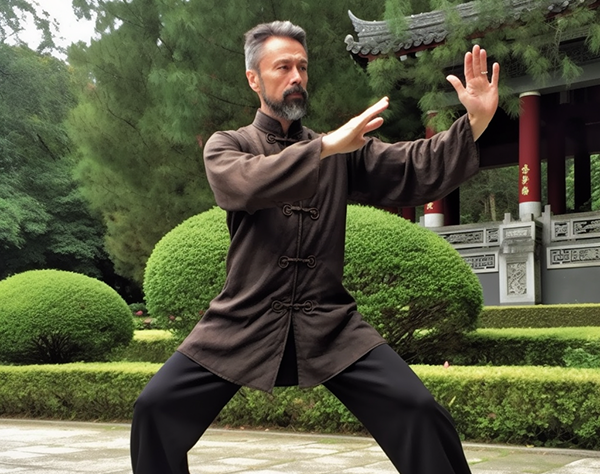
I sometimes get asked this question as people start to get a little further into their qigong journey. It is great, because it shows how much they are enjoying their qigong practice, and recognizing how many different benefits qigong can bring them. They start to wonder if they can just focus on doing their qigong practice to maintain their health and fitness, or if it is necessary to also devote some of their time and energy to other types of exercise.
As with so many things in life, the answer to this question depends on your specific situation and goals. Whether just focusing on your qigong practice will be enough for your fitness will depend on:
- Your current state of health and fitness
- What your fitness goals are
- What other activities you do on a regular basis
- What kind of qigong you are doing
In this article we will look at each of these factors that may influence whether you choose to just focus on your qigong practice, or whether you choose to also include other types of exercise into your regular routine.
State of Health and Fitness
The types of physical activity that you engage in will be greatly influenced by your state of health and fitness. If you are very healthy and have a good level of fitness already, then of course you will have many options of different types of physical activity that will be healthy for you to do. On the other hand, if you are in poor health and maybe just starting to rebuild your fitness, then it will be necessary to factor this in to the types of activity and exercise that you do.
In these situations qigong may be all that you need to progress your health and fitness. There are many types of qigong practice that are gentle, but can also be challenging in surprising ways and can improve your health and physical fitness in every way. Even simple qigong practices can be great for developing strength, balance, cardio vascular fitness, co-ordination, and flexibility. Because the movements are often done slowly and gently it can be easy to overlook just how many of these benefits come from the practices, and in fact many of these benefits come specifically from the slowness of the movements.

Standing in different stances and moving slowly from one posture to another develops a surprising amount of strength in the legs, and this become more pronounced as you make the stances you use in your practices deeper. Someone who starts our weak, can do the practices in a way that is manageable for them to begin with by using high and narrow stances and then gradually make their stances deeper and wider to challenge themselves more as they build strength through their practice. The slow transition of weight from one leg to another is also very effective for developing balance and stability.
The slow movement of the arms and torso also develops strength in the upper body, and the slowness of the movements helps the body to relax and find stability which can often be very helpful in rapidly increasing range of motion and flexibility. Some of the movement patterns challenge the co-ordination of the body in interesting ways as we do multiple things with the arms and legs at the same time. Doing these movements slowly allows the body to develop strong neural pathways to support enhanced co-ordination in the future.
We also sometimes have a tendency to think that we need to do hard physical exertion that makes us huff and puff to improve cardio vascular fitness. Those kinds of activities can be beneficial of course, but may not be suitable for someone with too low a starting point of health and fitness. The benefits of gentle qigong in improving cardiovascular function have been studied and proved to be surprisingly effective. Again the slowness of the movements and the large range of motion of the body used seem to be key to delivering a surprising level of challenge and benefit to the cardiovascular system in a safe and gentle way.
And of course different qigong practices also deliver a multitude of other benefits as well – balancing posture, emotion, organ functions, and other aspect of our energy. So when rebuilding health and fitness from a low level gentle qigong practices are a great choice, and will often be all that someone needs to start to move their health and fitness forwards.
Whether just doing qigong will continue to be enough for someone as their health and fitness improves will depend a lot on what goals they have for their fitness.
Fitness Goals
Some people are happy to just be healthy, while others have goals of being able to engage in different types of sports or other physical challenges that may require quite a lot more of their body than just being ‘healthy’. For example you can be perfectly health without being able to run a marathon, or lift 100kgs above your head, but yet that may still be something that you want to do, either for a sense of achievement or for the pure enjoyment of the activity.
In these cases where people have specific fitness or sporting goals, unsurprisingly qigong alone is probably not going to be enough to achieve those goals. They will most likely need to put a lot of time and effort into specific training to develop the capability of their body to achieve those goals. This could include lifting weights, running, stretching, and many other activity specific exercise activities to develop the specific capabilities they need to achieve those goals.

Qigong can certainly help them in working towards their aims, helping to maintain health and balance between all of the systems of the body so that they can get the most out of their other physical training, and possibly even giving them an extra edge in developing some of those physical capabilities. This is why historically qigong played such an important role in the training of martial artists – they didn’t practice qigong just because of tradition, they practiced because it brought them real results. If it didn’t they would have saved their time and energy for other activities that helped them achieve their goals more effectively. But they didn’t just do qigong, they also put a lot of time and effort into other types of training that we would consider to be more like ‘normal’ exercise – using heavy training aids and developing their fitness and strength through hard and sweaty exertion.
So for people with specific fitness goals, the question becomes not so much whether they can reach those goals through qigong alone, but rather how qigong can help them as one part of their overall training plan.
Other Regular Activities
Some people may want a higher level of fitness than they can achieve through just doing gentle qigong practices, but may find that the other activities they engage in regularly is enough for them to achieve and maintain that level of fitness.
A standard definition of fitness is: “the quality of being suitable to fulfil a particular role or task” and often the activity of simply doing those tasks is enough to provide the extra fitness required to be able to fulfil them.

So if you like hiking just doing qigong by itself may not be enough for you to have the fitness you need for hiking, but doing qigong and hiking regularly probably will be. Similarly if you have a physically demanding job (perhaps a mechanic, or farmer, or storeman, or many other kinds of jobs), then just doing the job is likely to help you develop all the physical attributes you need to be fit enough for that job. Qigong practice can fill in the extra parts of helping you to recover from the challenges of that job and keeping your body health and moving well so that you can avoid injury or imbalance from the challenges of the job, helping you to be able to do it with more ease and without negative long term effects. You may not need to do any additional exercise as well to maintain the fitness that you need.
A lot of our level of fitness comes from our overall level of activity – no matter what type of activity that is. So higher levels of fitness require doing more activity, and all the different types of activity we engage in add up together to develop our overall fitness. As mentioned above, if you have a physical job, or some sports or other physical activity you engage in regularly, those alongside your qigong practice may be enough for you to build and maintain a level of fitness that you are happy with. On the other hand, if you have a sedentary job and don’t engage in sports or other activities regularly, you might find it useful to consciously include some other types of exercise into your routine to maintain the level of optimal fitness that you desire. For many people this can be as simple as making sure they walk regularly each day to add to their baseline level of physical activity to complement their qigong practice, otherwise they might need to do a lot of qigong to do enough activity to build and maintain the level of fitness that they desire.
Types of Qigong
If you do want to do a lot of qigong, there is a lot of scope for including this in your life in different ways, and meeting your fitness needs through different types of qigong practice.
While many qigong practices are quite gentle, there are also some types of qigong that are inherently more physically challenging. Some good examples of these are Wild Animal Play, and Iron Shirt Qigong. While both of these types of practices can be done gently, they naturally lend themselves to being done in a gradually more and more challenging way. These practices have a close connection to Kung Fu and were specifically used to develop physical attributes of strength, flexibility, balance, speed and agility, and physical resilience to a high level, while also developing a nuanced awareness of energy character and flow and creating internal and external balance. The sky really is the limit with how physically challenging these practices can be made, so they can be a great type of practice for someone who really wants their main focus to be on what is happening with their energy, but also wants to develop their physical capabilities as well without needing to divert their attention to other types of exercise.

Even if you don’t desire to reach the levels of peak fitness and performance of a kung fu master, these practices can be done at a more moderate level that challenges you to the degree that you need to reach your desired fitness level, while adding variety and diversity to your qigong practice, along with new insights into your mind, body, and energy. They are also a lot of fun!
There is also the potential to bring awareness of your energy into all types of physical activity, and in a sense turn them into a type of qigong practice through this awareness – in which case just doing qigong can certainly be all you need for fitness, because it can include any type of exercise that you wish to do because you do them in a way that harmonizes your energy. The Enter The Flow qigong practices are a great way to develop this awareness and start to bring it into your daily life and activities. There are even a whole range of really enjoyable qigong walking practices that can help to develop this ongoing energy awareness along with their own specific benefits.
Conclusion
To recap – whether or not just doing qigong will be enough exercise for you to reach and maintain the fitness levels that you desire depends on several factors. What your current level of health and fitness is, what fitness goals you have, what other physical activities you engage in regularly, and what types of qigong practice you choose to do.
For someone just rebuilding their health, gentle qigong practices may be all they need to make good progress in developing their fitness, while people with specific sporting or fitness goals may need to do other sport specific exercise to reach those goals.
All the activities we engage in regularly contribute to our overall level of fitness, and people with physical jobs or hobbies and pursuits may find that these are enough to give them a good base level of fitness which their qigong practice complements – helping them to maintain health and balance. Other people may want to make sure to consciously include some basic regular physical activity into their lives alongside their qigong practice to make sure that they are getting enough activity overall, and this can often be as simple as making sure to walk regularly.
For those who really want to make qigong a big part of their life, the principles of qigong and the energy awareness inherent to it can be applied to all of our physical activities and types of exercise, in a sense making them a type of qigong. There are also many different types of qigong practice that can be explored, some of which can be very physically challenging and can be a great way to develop physical capabilities while still focusing primarily on the character and flow of our energy.
Wild Animal Play and Iron Shirt Qigong are two excellent examples of potentially more physically challenging qigong practices, and you can learn more about them in the comprehensive Inner Fire Qigong program. The Enter The Flow Practices are a great way to develop awareness of your energy applied to daily activities, and you can learn these practices in the Small Universe Qigong program.